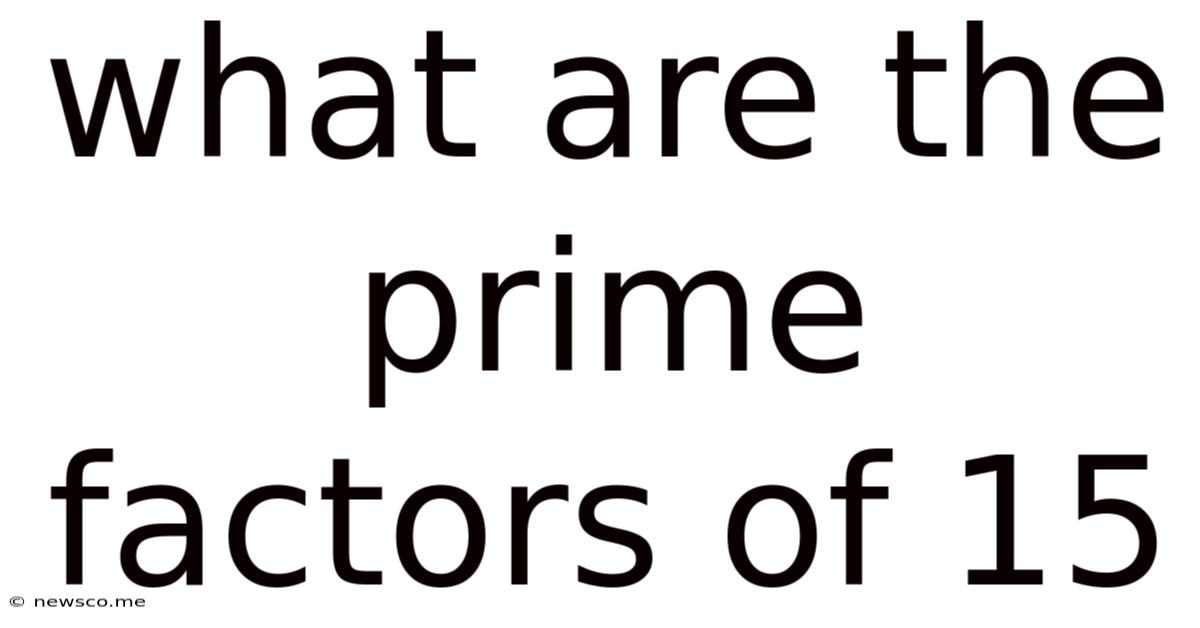What Are The Prime Factors Of 15
News Co
Apr 11, 2025 · 4 min read

Table of Contents
What Are the Prime Factors of 15? A Deep Dive into Prime Factorization
The seemingly simple question, "What are the prime factors of 15?" opens a door to a fascinating world of number theory. While the answer itself is straightforward, exploring the concept of prime factorization provides a foundational understanding of mathematics crucial for various applications, from cryptography to advanced algorithms. This article will not only answer the initial question but delve into the broader context of prime numbers, factorization, and their significance.
Understanding Prime Numbers
Before tackling the prime factors of 15, let's define what a prime number is. A prime number is a natural number greater than 1 that has no positive divisors other than 1 and itself. In simpler terms, it's only divisible by 1 and itself without leaving a remainder. The first few prime numbers are 2, 3, 5, 7, 11, 13, and so on. The number 1 is neither prime nor composite; it’s a unique case.
Key Characteristics of Prime Numbers:
- Divisibility: Only divisible by 1 and itself.
- Infinitude: There are infinitely many prime numbers; this is a fundamental theorem in number theory.
- Distribution: The distribution of prime numbers is a complex and fascinating area of study, with mathematicians still exploring its intricacies.
Prime Factorization: Breaking Down Numbers
Prime factorization is the process of expressing a composite number (a number that is not prime) as a product of its prime factors. This decomposition is unique for every composite number; that is, every composite number can be written as a product of prime numbers in only one way (ignoring the order of the factors). This uniqueness is guaranteed by the Fundamental Theorem of Arithmetic.
The Fundamental Theorem of Arithmetic:
This theorem states that every integer greater than 1 can be uniquely represented as a product of prime numbers, up to the order of the factors. This means that if we have a number like 12, it can be factored as 2 x 2 x 3 (or 2² x 3), and no other combination of prime numbers will multiply to give 12.
Finding the Prime Factors of 15
Now, let's get back to our original question: What are the prime factors of 15?
To find the prime factors, we need to systematically break down 15 into its prime components.
- Start with the smallest prime number, 2: 15 is not divisible by 2 (it's an odd number).
- Move to the next prime number, 3: 15 is divisible by 3 (15 ÷ 3 = 5).
- The result is 5: 5 is itself a prime number.
Therefore, the prime factorization of 15 is 3 x 5. These are its prime factors. There are no other prime numbers that can be multiplied together to equal 15.
Methods for Prime Factorization
Several methods can be used to find the prime factors of a number, especially for larger numbers. Here are a few common techniques:
1. Factor Tree Method:
This is a visual method often used for smaller numbers. You start with the number and branch out, dividing by prime factors until you're left with only prime numbers.
For 15:
15
/ \
3 5
2. Division Method:
This method involves repeatedly dividing the number by the smallest prime number that divides it evenly until you reach 1.
For 15:
- 15 ÷ 3 = 5
- 5 ÷ 5 = 1
The prime factors are 3 and 5.
3. Using the Sieve of Eratosthenes:
The Sieve of Eratosthenes is a powerful algorithm for finding all prime numbers up to a specified integer. While not directly a factorization method, it helps identify potential prime factors for use in other methods.
Applications of Prime Factorization
Prime factorization, seemingly a simple concept, has significant applications in various fields:
1. Cryptography:
RSA cryptography, a widely used public-key cryptosystem, relies heavily on the difficulty of factoring very large numbers into their prime factors. The security of this system depends on the computational infeasibility of factoring these large numbers.
2. Modular Arithmetic and Number Theory:
Prime numbers and their factorization are fundamental concepts in modular arithmetic and advanced number theory. These areas have applications in computer science, coding theory, and other mathematical disciplines.
3. Algorithm Design and Optimization:
Prime factorization algorithms are studied and optimized in computer science for their importance in various computational tasks.
4. Check Digit Algorithms:
Some check digit algorithms, used to detect errors in identification numbers, utilize prime numbers and their properties.
Conclusion: The Significance of Prime Factors
The prime factors of 15, 3 and 5, may seem insignificant at first glance. However, understanding the process of prime factorization and the properties of prime numbers provides a crucial foundation for various advanced mathematical concepts and practical applications. The seemingly simple question of finding the prime factors of 15 leads to a deeper appreciation of the elegance and power of number theory and its pervasive impact across multiple disciplines. The unique factorization property, guaranteed by the Fundamental Theorem of Arithmetic, underscores the fundamental role of prime numbers in the structure of mathematics itself. From the security of online transactions to the design of efficient algorithms, the impact of prime numbers is undeniable. The journey from the seemingly simple question about the prime factors of 15 to the vast landscape of number theory highlights the beauty and power inherent in seemingly basic mathematical concepts.
Latest Posts
Related Post
Thank you for visiting our website which covers about What Are The Prime Factors Of 15 . We hope the information provided has been useful to you. Feel free to contact us if you have any questions or need further assistance. See you next time and don't miss to bookmark.